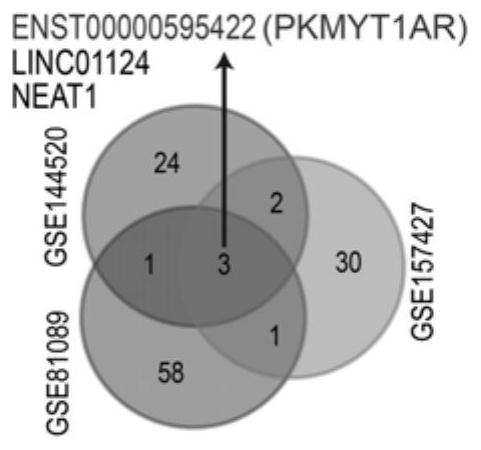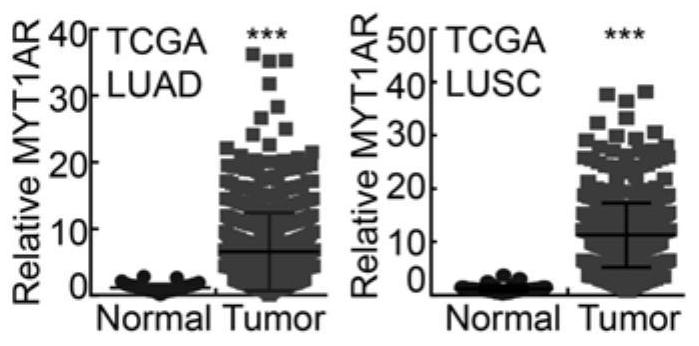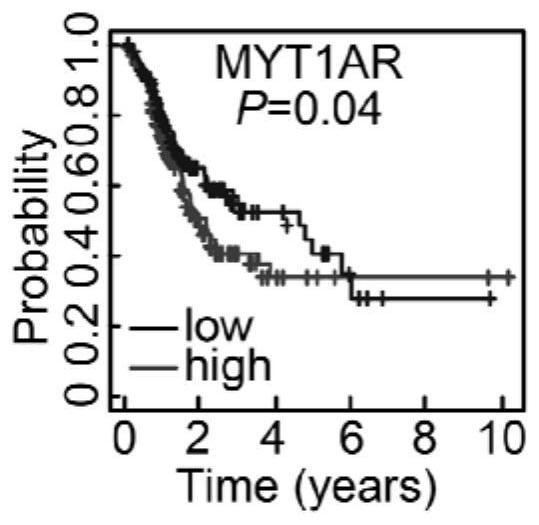Human PKMYT1AR gene and application thereof
A gene and gene expression technology, applied in the field of genes and their new applications, can solve the problem of unclear potential mechanism of specific downstream target genes
- Summary
- Abstract
- Description
- Claims
- Application Information
AI Technical Summary
Problems solved by technology
Method used
Image
Examples
Embodiment 1
[0076] Embodiment 1: Network database application
[0077] 1. Screening of research object PKMYT1AR
[0078] By downloading 3 data sets in the GEO (https: / / www.ncbi.nlm.nih.gov / geo / query / acc.cgi) database, the data sets and their research objects are (1) GSE81089 lung cancer and paracancerous tissues (2) GSE144520: Transcriptome sequencing gene expression dataset of A549 cells and cisplatin-resistance A549 / DPP cells; (3) GSE157427: Transcriptome sequencing gene expression data of lung cancer cells and lung cancer stem cells Set, logFC>2, p<0.01 in the data set were screened separately, and the obtained significantly up-regulated lncRNAs were taken as their common intersection.
[0079] The result is as figure 1 As shown, a total of 3 lncRNAs were obtained, including LINC01224, NEAT1 and ENST00000595422 (PKMYT1AR). LINC01224 and NEAT, which have been reported in many literatures, were removed, and ENST00000595422 was selected as the follow-up research object.
[0080] 2. Ana...
Embodiment 2
[0086] Embodiment 2: fluorescent quantitative PCR (qRT-PCR)
[0087] After the cells A549 and SPC-A1 are cultured until the density reaches 80-90%, discard the medium, wash once with PBS, add 1mL Trizol on ice, fully lyse, blow evenly with a pipette gun, and transfer to RNA-free 1.5mL centrifuge tube for enzyme; place the collected Trizol lysed cell solution at 4°C and centrifuge at 12000g for 5min, transfer the supernatant to a new 1.5mL centrifuge tube with a pipette gun; add 200μL chloroform, mix thoroughly and let stand for 5min , and then placed in a centrifuge at 4°C at 12,000g for 15 minutes. After centrifugation, it was divided into three layers. Transfer the upper layer of RNA to a new 1.5mL centrifuge tube; Place in a centrifuge at 4°C, centrifuge at 12000g for 10min; discard the supernatant, add 1mL of 75% absolute ethanol prepared with DEPC water and mix upside down, then centrifuge at 7500g for 5min at 4°C; discard the supernatant, and dry the precipitate until T...
Embodiment 3
[0090] Embodiment 3: RNA nucleoplasm separation experiment
[0091] Prepare about 10 7For A549 and SPC-A1 cells, discard the medium, wash with PBS, trypsinize the cells, resuspend in PBS and place on ice, add 500 μL cell lysate to treat, let stand on ice for about 10 minutes, and centrifuge the sample for 5 minutes (500g, 4°C) and put it on ice to separate the cytoplasm and nucleus of the cells. The supernatant is the cytoplasm and the precipitate is the nucleus. Add 500 μL of ice-bathed cell lysate to the In the nuclear precipitation part, shake and mix vigorously to lyse the nucleus. After the nuclear material is dissolved, perform RNA extraction and PCR analysis. In the subsequent qPCR analysis, U1 is used as the nucleus control, and β-actin is used as the cytoplasmic control; the results are as follows: Figure 4 In B, it shows that PKMYT1AR exists in both the cytoplasm and nucleus in A549 cells, but is mainly localized in the cytoplasm.
PUM
 Login to View More
Login to View More Abstract
Description
Claims
Application Information
 Login to View More
Login to View More - R&D
- Intellectual Property
- Life Sciences
- Materials
- Tech Scout
- Unparalleled Data Quality
- Higher Quality Content
- 60% Fewer Hallucinations
Browse by: Latest US Patents, China's latest patents, Technical Efficacy Thesaurus, Application Domain, Technology Topic, Popular Technical Reports.
© 2025 PatSnap. All rights reserved.Legal|Privacy policy|Modern Slavery Act Transparency Statement|Sitemap|About US| Contact US: help@patsnap.com



